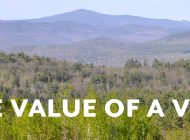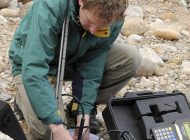A new study investigates potential impacts of second homes in the Northern Forest.
by Barbra Alan
The Northern Forest Region is home to more than 26 million acres of forestland, stretching from northern New York to Maine. It is the largest contiguous forested region in the eastern US and is a valuable source, both locally and globally, of wood for pulp and papermaking, wood products manufacturing, electricity generation, liquid fuels, and bio-based chemicals and other products.
It is also a valuable ecological resource, providing essential wildlife habitat, clean air, and clean water for the northeast and beyond. Millions of visitors come each year for hiking, fishing, hunting, canoeing, skiing, snowmobiling, and more.
More than two million people live in the region—a number that is steadily increasing as more people, drawn to the area’s natural beauty and remoteness, purchase and develop second homes. As Northern Forest towns grapple with the changes to their landscape, researchers and residents alike are concerned about the potential economic, ecological, and social effects of this phenomenon.
A New Boom
“The Northern Forest has traditionally gone through boom and bust cycles of natural resource extraction, namely, logging,” says Brian Eisenhauer, director of PSU’s Office of Environmental Sustainability and interim director of the Center for the Environment. “With the paper industry on the decline, the land use is changing. Many timber companies are divesting their land holdings into timber investment management organizations, many of which are turning the land into residential properties, primarily second homes. The environmental impacts of this land use change could be huge. For example, where we used to have ten landowners controlling a thousand acres, now we’ll have a hundred or more landowners controlling a thousand acres. This will create fragmentation and variation in how the land is managed.”
To better understand the impact of second homes in the Northern Forest region, Eisenhauer and other researchers in the Northeastern States Research Cooperative (NSRC), a competitive grant program for Northern Forest research, are creating a county-level database of second-home development. Information from interviews and surveys of long-time residents and second-home owners will be included in the database. Using this information, the NSRC hopes to be able to identify current and future hot spots of second-home growth, and assess the environmental, social, and economic impacts of second homes. The group hopes that the information will ultimately empower local and regional decision makers to implement effective local and regional policies that maximize the benefits of second-home development, while mitigating the negative impacts to the region.
The Project
The project got under way in 2007, with research teams from institutions including Cornell University, Penn State, the University of Vermont, and the University of Maine working in communities in the Northern Forest, developing interview questions, and interviewing both long-time residents and second-home owners. The New Hampshire research team consisted of Eisenhauer and Christian Weber ’09, now a graduate student in PSU’s Environmental Science and Policy program. “I had worked with Brian as an undergraduate and developed a great relationship with him, so when he offered me the opportunity to work with him again, I was excited to take it,” says Weber, whose work on the project was funded through a Northern Forest Service grant.
Eisenhauer and Weber selected Pittsburgh, New Hampshire’s northernmost municipality with a population of just under 1,000, as their focus and collaborated on the interview protocol. Last summer, Weber conducted 30 interviews of both long-time residents and second-home owners over the course of four days. What he found was, regardless of how they came to it, both groups “have a love of the land. Whether they’ve lived there all their lives, or only recently discovered it, they value the same things about the region, and want to protect it.”
In late October, the NSRC researchers convened at PSU—the central location for those involved—to share the results of their interviews. “The next step,” says Eisenhauer, “is to develop and conduct a comprehensive survey of the entire region. The interviews will inform the contents of the survey.”
Eisenhauer and Weber have leveraged their involvement in the project by using it as the foundation for a special topics course, Second-Home Development in the Northern Forest, which they co-taught last fall.
The Course
The course was held in a classroom in EcoHouse, a living, learning laboratory in which the students, some of whom live there, can model sustainable living. “A major impact of second homes in regard to sustainability is their actual footprint, and the energy they demand,” says Eisenhauer. “We used EcoHouse as a way to learn about sustainability concepts in the home.”
In class, students learned about sustainability and how it is implemented in various fields, reviewed current techniques used to mitigate the environmental impacts of homes, and explored the key issues in the Northern Forest. “It was more engaging than hypothetical topics because these students are passionate about the outdoors, and some of them grew up in the Northern Forest region or enjoy recreational activities there,” says Eisenhauer. “That tangible aspect helped them engage.”
“Now that I understand some of the issues facing this bioregion, I feel that it’s my responsibility to protect it,” says Liz Kelly, an environmental science and policy major.
That’s just the kind of reaction Eisenhauer loves to see in his students.
“The goal for both the course and the research is understanding, which I believe should lead to action,” he says. “We’re trying to get a better sense of how communities are impacted [by second-home development] and use that to inform outreach and other activities that will help mitigate some of the impacts that residents—both long-term residents and second-home owners—don’t want to see.”
Top: Peter Rowan ’04G photo. Bottom: Map of the Northern Forest Region courtesy of Northern Forest Center.
Tags: Brian Eisenhauer Center For the Environment Christian Weber Northeastern States Research Cooperative Northern Forest Office of Environmental Sustainability Pittsburgh second homes















